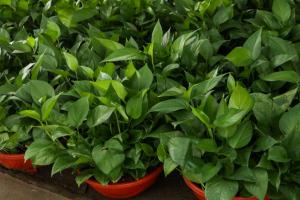Introduction
Indoor plants have the ability to enhance any space they are placed in. They add a touch of lushness, natural beauty, and even health benefits to your surroundings. However, not everyone has access to outdoor spaces or the luxury of keeping their indoor plants in planters with drainage holes. In this article, we will discuss how to pot indoor plants without drainage.
Why Potting Without Drainage Should Be Done with Caution
One of the most important things to keep in mind when potting indoor plants without drainage is that it should be done with a great deal of care. Without a drainage hole, it is much easier to overwater the plant, which can lead to root rot, mold growth, or even plant death. Be very cautious with watering and ensure that the potting mix used is well-draining.
Materials to Be Used for Potting
When potting indoor plants without drainage, it is important to use the right materials to ensure that the plant stays healthy. Here are some materials to consider:
1. Potting Mix: Choose a mix that is specifically formulated for indoor plants without drainage holes. This should be a well-draining mix with perlite, vermiculite, or sand to improve drainage. Avoid heavy soil, which can suffocate the roots.
2. Pebbles or Stones: Place a layer of small pebbles or stones at the bottom of the pot to create a reservoir for excess water that will not drain out. This will help prevent the roots from sitting in standing water.
3. Charcoal: Adding a layer of activated charcoal on top of the pebbles or stones will help absorb any impurities or toxins that may be present in the water.
4. Watering Can: Use a watering can with a narrow spout or a spray bottle to water the plant, as it will be easier to control the amount of water you use.
Steps for Potting Indoor Plants without Drainage
Now that you have your materials, it is time to get started with the potting process. Here are some steps to follow:
1. Add a layer of pebbles or stones to the bottom of the pot.
2. Add a layer of activated charcoal on top of the pebbles, if desired.
3. Add the potting mix, filling the pot about two-thirds of the way up.
4. Dig a small hole in the center of the potting mix and place the plant in it. Make sure the roots are well-covered with potting mix.
5. Add more potting mix around the plant until the pot is filled to within an inch of the rim.
6. Water the plant slowly and carefully, making sure the water spreads uniformly through the potting mix. Stop watering when you see water running out of the bottom.
7. Place the pot in a location where it can receive adequate sunlight and proper air circulation.
Tips for Care and Maintenance of Indoor Plants without Drainage
To ensure that your indoor plants without drainage stay healthy and thrive, here are some tips to follow:
1. Do not overwater. Be very careful with watering and avoid watering the plant until the top inch of soil is dry.
2. Make sure the potting mix is well-draining to prevent root rot.
3. Check the plant regularly for signs of stress or illness. If you see yellowing leaves or other symptoms, investigate the cause and resolve the issue as soon as possible.
4. Provide adequate sunlight and fresh air circulation to the plant.
5. Fertilize the plant with a balanced, water-soluble fertilizer once a month during the growing season.
Conclusion
Potting indoor plants without drainage can be a challenge, but it is not impossible. With the right materials, careful watering, and proper care, your indoor plants can thrive and add beauty to any space. Follow the steps and tips outlined in this article to ensure the health and longevity of your indoor plants. Happy potting!

 how many times do yo...
how many times do yo... how many planted tre...
how many planted tre... how many pine trees ...
how many pine trees ... how many pecan trees...
how many pecan trees... how many plants comp...
how many plants comp... how many plants can ...
how many plants can ... how many plants and ...
how many plants and ... how many pepper plan...
how many pepper plan...






























